
Our buddy Chris Davies has done a review of the HTC Flyer, that cute little 7-inch HTC handheld tablet, over on our sister site SlashGear. What you’re about to view is a bit of a re-write review based on what he’s told us about the device thus far. This is the first tablet we’ve seen from HTC since 2008, the last being a Windows device by the name of HTC Shift. So how is the Flyer? We got a tiny glimpse of this piece of candy back at Mobile World Congress 2011 and a much longer look at its USA cousin via Sprint at CTIA 2011 – that one was black, this one’s white, that one has the stylus sold separately while the Flyer has one that comes with. Will this Euro HTC superstar add up?
Hardware
The Flyer’s HTC pedigree is obvious, looking somewhat like an oversized Desire S with its unibody-style aluminum and white plastic insert-sections. It’s chassis measures 7.7 x 4.8 x 0.52 inches, a little longer and thicker than the original Samsung Galaxy Tab. Its also heavier because of the metal, but that makes this tab feel more sturdy than the Galaxy.

The 7″ size makes it comfortable to hold in one hand, and the screen bezel is wide enough that we could hold the Flyer like a book without tapping the screen on accident. The only physical controls are the power/lock button on the top edge, with an integrated status light, and a volume rocker on the right edge. There is a 3.5mm headphone jack on the top, and a microUSB port on the bottom.

Going to the back, there is a 5-megapixel autofocus camera (no LED flash), and stereo speakers. Pulling off the lower plastic section reveals the SIM slot for the triband HSPA/WCDMA (and quadband GSM/EDGE) modem in our 3G review unit, and the microSD card slot. There is 32GB internal storage, though the WiFi-only Flyer has half that amount. The Flyer also has WiFi b/g/n, Bluetooth 3.0, GPS, an ambient light sensor, g-sensor and digital compass, as well as a front-facing 1.3-megapixel camera for video calls.
Unboxing and First Impressions
[vms 39b5002a3f8909ecb88f]
HTC has opted for a single-core, Qualcomm’s MSM8255 1.5GHz chip in the Flyer, paired with 1GB of RAM. The Flyer can’t be used as a phone, and has 3G radio only for data connectivity. Similar to the Galaxy Tab, the Flyer’s screen is a 7 inch, 1024 x 700 capacitive touchscreen. The LCD panel is bright and clear with decent colors. The rotating buttons that we like so much on the Incredible 2 are missing, but there is a second set of touch-sensitive keys. If you hold the tablet in landscape orientation and you get backlit home, menu, back and “stylus” buttons underneath the short edge of the display; rotate it into landscape orientation and you get the same buttons underneath the long edge. Unfortunately, we sometimes wanted the alternate set of keys, so a choice would be nice.
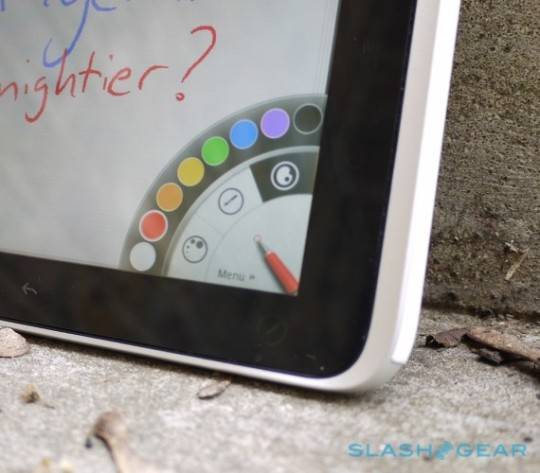
Ok, so the stylus. HTC offers a “Magic Pen” with the tab for text entry, annotation and sketching. Using N-Trig’s active digitizer technology, that allows for far greater accuracy (as well as pressure sensitivity) when writing on the screen. The tab also automatically shuts off the regular, multitouch capacitive touch panel when the pen’s nib is near, so that you can rest your palm on the display without accidentally triggering anything. In Europe, the Magic Pen will be bundled with the Flyer; in the US, it will be a roughly $80 accessory. Since we are all so used to, and love, our touchscreens, the thought of a stylus seems like going backward. But wait. HTC has done a good job of adding digital pen functionality to Android, and the Flyer’s pen glides smoothly across the Gorilla Glass on the display. We’ll go into more stylus details in the software section.

There is no physical place to put the stylus, however, unless you use the leather slip case with magnetic flap with a loop on the back for it. This is bundled in the UK edition, but you can bet we’ll have to pay for it here in the US. We weren’t crazy about the white finish – although matching the Flyer’s color scheme – it seems to invite scuffs and blemishes; and leaving the pen on the outside and unprotected feels risky. The case also adds bulk, so it can be a pain if you want to fit the tab in your pocket. I would lose the stylus, there is no question about it.
Software and Performance
HTC has opted for Android 2.3 Gingerbread, the latest version intended for smartphones. They’ve added HTC Sense with some significant modifications to the familiar UI to take into consideration the tablet form factor.
Unlike HTC phones, the Android homescreen now works in both portrait and landscape orientation. Both get a carousel-style interface, with endless rotation; flick the homescreen fast, and the perspective pulls back to show the eight panes spinning. A pinch-zoom gesture shows all eight thumbnailed. It’s slick and swift, the 1.5GHz processor showing its grunt. Pull down the notification bar and there are shortcuts to the last ten apps used as well as settings shortcuts and alerts; in portrait orientation the latter are on different tabs, while in landscape they’re all visible at once.
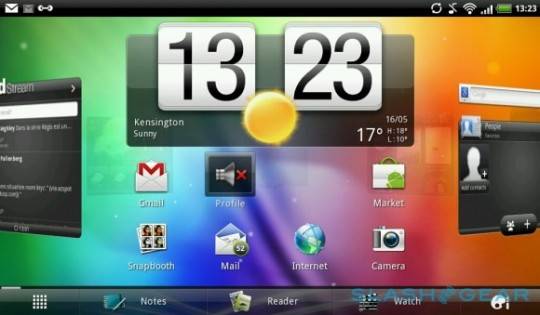
Along the bottom of the display there’s the app menu button, then shortcuts for HTC’s new Notes app, HTC Reader and HTC Watch, which we’ll cover separately later. The usual Customize button is also included, which allows you to change the wallpaper, add icons, shortcuts and widgets – both the standard Google fare and HTC’s own – and, for the first time, tweak the lock-screen. That, as we saw on the HTC Sensation, can now show the weather along with four app shortcuts – user assignable, of course. To unlock the Flyer normally, you drag up the large ring at the bottom of the screen; to instantly unlock and load an app, you drag that icon down to the ring. It works well, though we did spot some glitchiness in the animation before the apps loaded.
The usual HTC array of software is preloaded, so you get FriendStream with Facebook and Twitter feeds, the Media Control app for handling DLNA streaming, and the heavily-animated Weather app complete with homescreen widget. There’s also Amazon’s MP3 store app, HTC Hub for wallpaper, ringtone and other downloads, HTC Likes with suggestions, Locations, the Teeter game, a Task Manager app and WiFi Hotspot, for sharing the 3G connection with up to eight WiFi-tethered clients.
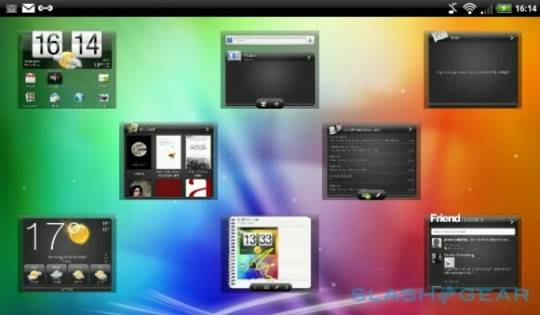
Some of the standard Android software comes into its own on the Flyer. The Car Panel, which offers chunky, finger-friendly shortcuts to navigation and multimedia for use while driving is particularly suited to the tablet’s 7-inch display. HTC also throws in Dock Mode, which shows weather, recent FriendStream activity and some app shortcuts (plus has a backlight dim button so that you can use the Flyer as a bedside clock). It can be set to automatically load when you drop the slate in the (optional) dock – which we didn’t have to review – as well as optionally turn on WiFi Hotspot sharing as well.
In addition to the standard camera and camcorder apps, there’s Snapbooth, a somewhat gimmicky app that uses the front-facing camera to take vanity shots that can be mangled with various special effects. It’s good for a few minutes fun, at least. HTC’s online Sense suite also gets an outing, offering remote access, tracking and locking of the Flyer. Unfortunately, you can only have a Sense account active on one HTC device at a time – signing in on the Flyer prompted us to unlike the account from the HTC phone it was currently being used with. Considering the Flyer lacks phone functionality on its own, that means the HTC-faithful will have to pick whether they want to use their Sense account with the tablet or their smartphone, rather than having it on both.
HTC Flyer Highlights
[vms 07203749ae32dd0e7d64]
Most of the time, HTC Sense means that the absence of Honeycomb isn’t felt. But that’s not always the case. Like Samsung did on the Galaxy Tab, HTC has reworked its Mail and Calendar apps to suit the greater screen real-estate on offer, with a two-column email view when the Flyer is held in landscape orientation, and various day, week, month and year views in the calendar. Both support multiple accounts and are far more usable than their phone cousins. The gallery, too, uses the same two-column layout, with albums on the left and previews – with sharing buttons – on the right. Similarly, the browser has a tab preview bar along the top, showing live thumbnails of all your open pages.
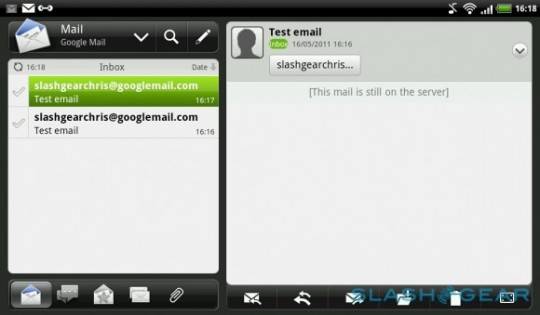
Unfortunately, you don’t get Google’s own tablet-version of Gmail, instead you have the regular smartphone app. That’s fine on a phone, but is stretched and wasteful with space on the Flyer’s 1024 x 600 panel. Similarly Google Talk is the basic phone version. 7-inch displays are often ideally-scaled to type on with both thumbs, and the Flyer is no different. HTC’s custom keyboard doesn’t stretch to a dedicated number row, but does have navigation keys, sensible auto-predictions like @ and .com in email text boxes, and simple access to Android’s voice recognition. The auto-suggestions are also accurate, with prompted words popping up with no lag or delay.
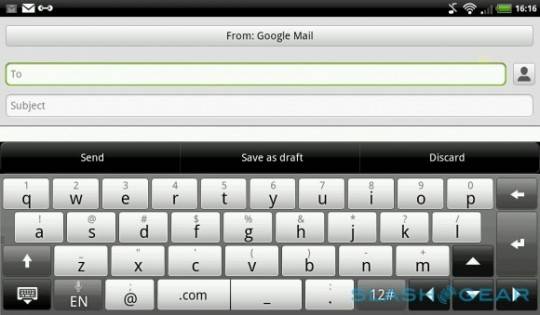
Performance overall was mixed, depending on quite how much we stressed the Flyer with multiple-running apps. In Quadrant Standard, the tablet scored 1817, while in Quadrant Advanced it managed 2166. Linpack Pro came in at 55.009 MFLOPS. That is similar to what we’ve seen from Tegra 2 based Honeycomb tablets.
Magic Pen
Say stylus and most people immediately think of the fiddly toothpick that came with Windows Mobile phones, or the old Palm Pilots. The Flyer has more in common with Windows tablets, though again, don’t let that put you off. Basically, rather than a resistive touchscreen that simply responds to pressure, or a capacitive stylus that pretends to be a blunt fingertip so that the screens used by the iPad, XOOM and other recent slates are tricked into recognizing them, the Flyer uses a special battery powered “Magic Pen” that communicates with a second layer sandwiched with the regular, finger-friendly touchscreen. That second layer knows not only where the pen nib is, but also how hard you’re pressing: that way, lines on-screen are thin when you press lightly, or thick when you press harder.
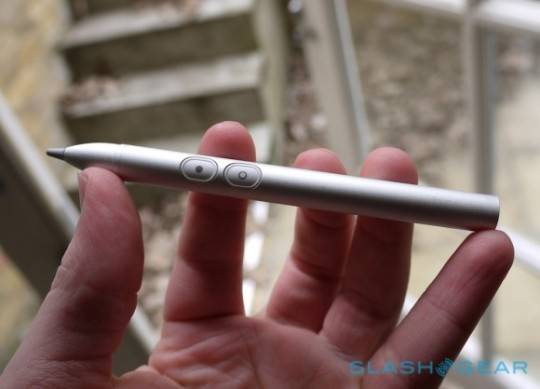
The pen matches the Flyer’s brushed aluminum, and has a pair of buttons on its side. One puts the stylus into highlighter mode, the other text selection. It runs on an AAAA battery – HTC reckons you should get a few months use out of it. Places where the pen can be used are flagged up by the stylus button turning green; tap that, and a radial menu of pens, tools and colors pops up in the lower left-hand corner of the screen.
In most places, the pen is used to grab screenshots or “Scribbles”, triggered by tapping the pen once on the display. The resulting image can be doodled on and annotated and then instantly shared – using the normal Android options – or pasted into a new Notes document (more on that later).
It all works, but it’s not perfect. While the Flyer uses a similar active digitizer to what you’d find in a Windows 7 tablet PC, it doesn’t feel as accurate. That usually means making your handwriting slightly larger, which is frustrating on a 7-inch display. Meanwhile, although HTC claim a couple hundred levels of pressure sensitivity, there’s little visible difference between the two extremes. There’s also no handwriting recognition, and you can’t handwrite emails or jot into text-entry boxes.
There is some confusion between finger-touch and pen-touch, however. There are times when you want to use the stylus, and you can’t. So there is a lot of flipping back and forth between finger and stylus, and taking screen shots when you wanted to open a menu.
HTC Notes
Notes is where the Flyer’s Magic Pen comes into its own, and is arguably the center-point of the whole tablet. As we said, HTC took it on itself to add active stylus support to Android, and Notes is where that energy pays off. On the face of it, it looks like any other memo app: a place for a title then room for notes. However, on the Flyer those notes can either be thumbed in using the on-screen keyboard, or written in using the Magic Pen. The same radial menu of pen types, colors and other tools – offering highlighters, pencils, felt-tips and more – pops up, and you can sketch or scribble away to your heart’s content.
There’s also audio recording, which is indexed according to your note-taking. As you scribble, the Flyer automatically creates bookmarks through the recording that match text with audio: you can either see a thumbnail of the relevant note as the audio plays back, or skip to the relevant section of the audio by tapping on the note. It works, but it lacks granularity: a Livescribe pen, for instance, goes directly to the point of the audio recording, while the Flyer is a little less aggressive with its timestamping. Finally, there’s a shortcut to the camera so that you can shoot an image, have it instantly pasted into a new note, and then annotate it as you see fit.
HTC has also partnered with Evernote, which is a huge plus. You can synchronize your notes between all your devices using the service.
HTC Reader
You can of course load your favorite eReader app from the Android Market. HTC,also includes its Reader app, offering a variety of titles – both free public domain ebooks and newer, paid ones – for download direct to the slate.

In Reader, you also get the opportunity to use the Magic Pen, you can annotate and sketch either keeping neatly to the margins or scrawling all over the place, as well as highlighting passages. Reader automatically slots in a bookmark on any page you write on, so you can find your notes later.
HTC Watch
HTC Watch is the company’s attempt to make money from the multimedia uses of the tablet. Basically a movie and TV episode store, it offers both rentals and purchases – depending on title – with prices ranging from £7.99 to £9.99 to buy 720p movies in the UK or £2.49 to £3.49 to rent them. TV episodes come in at £1.49. Previews can be streamed over 3G or WiFi connections – there’s about 5-10 seconds of buffering before they play – but purchases can only be downloaded over WiFi. You can only watch your purchases on an HTC device, though, there is no way to transfer it elsewhere. It will be interesting to see what happens with this in the US.
OnLive
Streaming gaming service OnLive is currently only available in the US, and since this was a UK Flyer, we couldn’t test it. When the US version of the tablet goes on sale, it will offer the chance to play full games – the sort you’d normally need a beefy PC or a proper console – on your slate while on the move. We’ll revisit OnLive on the Flyer when the service is operational.
Camera and Multimedia
The Flyer’s main camera claims to be 5-megapixels, but some of them seem to be missing. Camera performance is plain disappointing, falling well short of what HTC’s current crop of 5-megapixel smartphones can manage. Stills are fuzzy, lack definition and have uninspiring, muted colors, while video is somehow even worse. HTC claims the Flyer is shooting 720p HD, but as you can see in our sample clip below it hardly looks that way.
The upside is that close-ups of text – such as grabbing a snapshot of a magazine article – come out reasonably well; that’s handy when you then import that shot into Notes, and sync it over to Evernote for OCR.
Media playback is another mixed bag. HTC says the Flyer will work with AAC, AMR, OGG, M4A, MID, MP3, WAV and WMA audio files along with 3GP, 3G2, MP3, WMV, AVI and Xvid video files, up to 720p, and indeed we had no problems with those. Trying more ambitious files, however, and the Flyer’s processor began to struggle. The stereo speakers lack voice, sounding insipid and reedy; better to plug in headphones or use an A2DP pair.
The Flyer lacks a dedicated HDMI output. However, like the Samsung Galaxy S II, its USB port apparently supports MHL. We were unable to test this, however.
Battery
The Flyer’s 4,000 mAh battery is non-user-replaceable, and HTC says users should see up to four hours of video playback or between 820 and 1470 hours of standby.
In practice, we found that with a mixture of push email turned on, various social network apps updating, and a fair amount of GPS mapping, browsing, music and video playback and some camera use, the Flyer made it comfortably through to the end of the day. With lighter, more sporadic use – as is perhaps common for tablets – we would probably see it run for a couple of days on a single charge. There are some sensible power management options, including the ability to turn off email checks overnight when you’re unlikely to need the very latest messages.
Wrap-Up
The Flyer has this going for it: It does not try to be an iPad clone. The Magic Pen could use some improvements, but it is a useful tool, and using it for notes is very handy. Pairing the notes function with Evernote is also a great idea. HTC has opened the API of the Pen to third-party developers, so we hope to see more functionality coming from that front.
HTC needs to be clear that dual finger and pen interfaces are integral into its vision of tablets. The UK prices are £599.99 for the 32GB version, while the 16GB WiFi-only model comes in at £479.99 – users will want to know that HTC is sticking with the stylus concept. The Flyer has a lot of potential, and is a quality piece of equipment. It’s worth giving a try if you want something different in a tablet, with added functionality that comes with the Magic Pen.
We’re anxiously awaiting our chance to take a peek at the US version soon – pens ahoy!



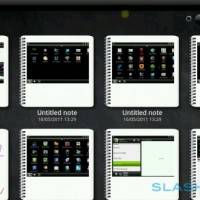

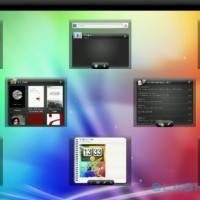
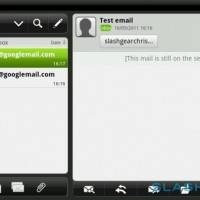

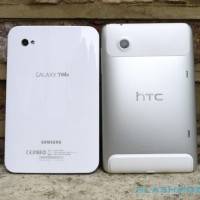


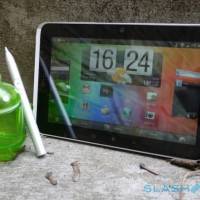
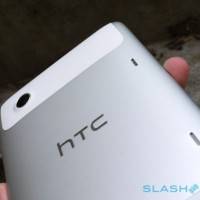
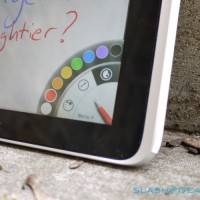
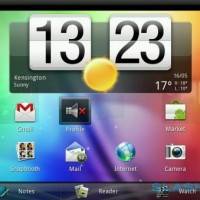
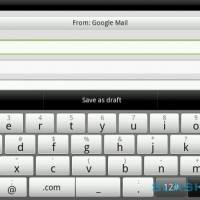
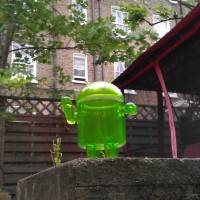








Where do I get one of those AAAA batteries?
I honestly TL;DR’d this review because after seeing the UI in action, I became disinterested in this device. You can only use a small portion of the screen at one time. Why would they do this? The stylus seems gimmicky to me, like 3D on anything. I’ll keep my 10.1″ Honeycomb tablet and my 4.3″ smartphone. I don’t need an in-between device.
Where do I get one of those AAAA batteries?
I like the phone…